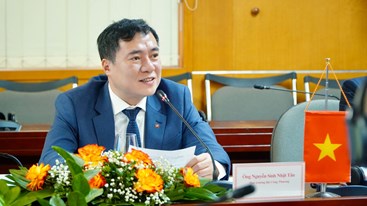Sunday, 28/04/2024 | 20:50 GMT+7
Mr. Truong Duc Tri, MSc., Secretary of the Office for National Target Program to response to climate change, Head of Planning Office - Department of Hydro-meteorology and Climate Change - Ministry of Natural Resources and Environment, said: Clearly aware of the unforeseen impacts of climate change, the Government has directed the completion of legal documents, creating legal framework for prevention and mitigation of natural disasters, in a response to climate change.

“
The strategic objectives of the Program (issued under Decision 158/2008/QD-TTg by the Prime Minister) is to assess the extent of the impact of climate change on different areas, sectors and localities under each period, in order to build feasible action plans to successfully cope with climate change both for long term and short term.
According to Mr. Tri, by promoting the Program, we will ensure a sustainable development, taking the opportunities to develop the economy towards low carbon.
In addition to this action program, we also have many other policies to promote a “green”, environment friendly growth model for our economy.
In the recent article on the theme “Rapid and sustainable development as a leading point throughout the socio-economy development strategy of our country”, Prime Minister Nguyen Tan Dung stated that economic development is closely associated with protecting and improving the environment; therefore in creating sustainable development , the most influential actions we can take are actively coping with the threat of rising sea level; applying material saving, energy efficiency technology and developing a “green” economy.

These contents will be reflected throughout the plan for socio-economic development of the whole country as well as in each field, in each locality and unit.
One notable event of the “green development” was a recent promulgation by the government of Decision 567/2010 on the "Development Program for non-heated building materials until 2020”. Accordingly, by 2015 non-heated building materials will have been developed, produced and put into use in replacement of the refined clay bricks. The program’s target is to raise proportion of non-heated materials to 20 – 25 % by 2015 and 30 – 40% by 2020, advancing to a complete elimination of refined clay brick manufacturing units. Starting from 2011, large building projects (having 9 floors or above) will have to use at least 30% of non-heated light weight building materials in the total construction materials.
This is a very practical Decision, because in order to produce one billion refined clay bricks of standard size, 1.5 cubic meters of clay – equivalent to 75 hectares of agricultural land, and 150 thousand tons of coal are needed, releasing into the environment about 0.57 million tons of carbon dioxide causing the green house effect and other toxic exhaust fumes polluting the environment.
In 2007, the Prime Minister also issued Decision 130/2007/QD-TTg on some policies and financial mechanisms for investment projects under the Clean Development Mechanism (CDM).
Since then, an increasing number of CDM projects have been implemented in our country, such as a project called “"Recovery and use of exhaust gas at Nam Son - Ha Noi landfill", a project to increase the energy efficiency of industrial boilers, a project gathering companion gas at Rang Dong mine… These projects have helped reduce hundreds of thousands tons of carbon dioxide released into the environment.
Develop clean energy sources
Having the same point of view with Mr. Truong Duc Tri on the
issue of economic development towards low carbon, Mr. Do Mong Hung, Head of
Department of manufacture techniques, Electricity of Vietnam, also emphasizes
the issue of clean and renewable energy development.
Mr. Hung said that the development of hydro-power is one of
the government’s priorities.
However, according to Mr. Hung, in the plan for electricity development, the proportion of hydroelectricity in total electricity source will be reduced in the near future, by 2020 it is estimated to account for only 26% of total installed capacity of the electricity system and by 2060 only 16%, in order to minimize the negative impacts of climate change on power generating capability of the system.
“In order to lessen the causes and impacts of climate change on production of electricity, what we should do are to focus current public investment on building our first nuclear power plant, which is planned to begin operating in 2020 and in subsequent years; and to increase the use of renewable energy such as wind power, solar power to generate electricity”, said Mr. Hung.
In addition, we should focus on protecting, restoring and developing the watershed to maintain sustainable water resources for long-term operation of hydro-power plants, avoid having a shortage of water sources.
Mr. Hung also expressed his expectation of receiving support from consumers and businesses in reducing the negative impacts of climate change. Consumers should have more economical and efficient use of power; and businesses should invest more on high performing devices and equipments, applying energy efficiency technology to consume less electricity and reduce the amount of carbon dioxide exhaust.
By Nguyen An

.png?w=367&h=206&mode=crop)






.jpg?w=367&h=206&mode=crop) Energy efficiency and conservation usage is an important aspect of the national energy development strategy
05/03/2024
Energy efficiency and conservation usage is an important aspect of the national energy development strategy
05/03/2024
 Challenges and Opportunities to promote energy efficiency market in Vietnam
Challenges and Opportunities to promote energy efficiency market in Vietnam
 The Ministry of Industry and Trade requests government agencies to coordinate in organizing Earth Hour 2024
The Ministry of Industry and Trade requests government agencies to coordinate in organizing Earth Hour 2024
 Consultation on Energy Efficiency Boiler Catalogue and Wood Drying Guideline
Consultation on Energy Efficiency Boiler Catalogue and Wood Drying Guideline
 Son Ha Co., Ltd, applies energy efficiency and conservation measures
Son Ha Co., Ltd, applies energy efficiency and conservation measures
.png?w=367&h=206&mode=crop) Request for expression of interest - C2.1.13: Capacity Building on energy efficiency policies development
Request for expression of interest - C2.1.13: Capacity Building on energy efficiency policies development
 Phuc Kien Co., Ltd., is effectively implementing energy-saving measures
Phuc Kien Co., Ltd., is effectively implementing energy-saving measures
 Request for expression of interest - C2.1.12: Independent monitoring of safeguards implementation
Request for expression of interest - C2.1.12: Independent monitoring of safeguards implementation